Reliable Control Valves: Key Components for Efficient System Management
Reliable Control Valves: Key Components for Efficient System Management
Blog Article

Maximize Energy Financial Savings and Comfort With Advanced Structure Automation Controls
In the world of contemporary architecture and center monitoring, the integration of advanced structure automation manages stands as a pivotal advancement. By harnessing the power of automation, structures can adjust, react, and progress in methods that were when unbelievable.
Energy Efficiency Conveniences
Power effectiveness benefits can substantially reduce energy usage and functional expenses in structures. By implementing energy-efficient practices and modern technologies, building proprietors and operators can achieve significant financial savings while additionally adding to environmental sustainability. One of the main advantages of improving energy performance in buildings is the reduction of utility bills. Energy-efficient systems, such as sophisticated building automation controls, can enhance making use of resources like illumination, home heating, and air conditioning, resulting in reduced energy expenditures over time.
In addition, boosted energy efficiency can prolong the lifespan of building tools and systems. By operating a lot more successfully, heating and cooling systems, light, and other structure elements experience much less deterioration, resulting in minimized maintenance and substitute costs. In addition, energy-efficient buildings often regulate greater home values and rental rates, providing lasting monetary benefits to owners.
Additionally, power efficiency can improve occupant convenience and productivity. Appropriately regulated interior settings with optimal illumination and thermal problems create a more helpful and pleasurable work area, leading to enhanced employee complete satisfaction and efficiency. In general, the energy performance benefits related to innovative structure automation controls are complex, incorporating expense savings, ecological stewardship, and owner health.
Improved Comfort Control
Enhancing comfort control in building atmospheres needs an innovative assimilation of innovative automation systems for optimum resident wellness. By utilizing advanced building automation controls, centers can customize the interior environment to fulfill the specific needs and preferences of residents. These systems enable accurate policy of temperature level, air flow, and illumination, producing a comfortable and efficient atmosphere. Passenger fulfillment and performance are very closely connected to thermal convenience, making it necessary to have systems in position that can adapt to transforming conditions in real-time.
Boosted comfort control surpasses basic temperature level adjustments. It consists of attributes such as individualized settings, occupancy sensing units, and natural light use to create a responsive and vibrant setting. By incorporating these innovative controls, structures can not only improve convenience but likewise boost energy effectiveness by optimizing system operations based upon real occupancy and usage patterns. Eventually, focusing on occupant comfort with innovative automation systems results in an extra satisfying and much healthier indoor environment.
Operational Performance Improvements

In addition, the implementation of real-time surveillance and analytics devices enables structure operators to recognize energy inefficiencies and functional anomalies immediately. By continuously keeping track of power usage patterns and system efficiency metrics, modifications can be made in real-time to maximize energy intake and guarantee peak functional effectiveness. control valves. In addition, integrating need reaction techniques right into building automation controls can better improve functional effectiveness by dynamically readjusting power usage based upon grid problems and pricing signals
Indoor Climate Optimization
Effective interior climate optimization is an essential facet of building automation controls, making certain occupants' comfort and health while making the most of power financial savings. By utilizing sophisticated sensing units and controls, building automation systems can continuously adjust and keep an eye on temperature level, humidity levels, air high quality, and air flow to develop an optimum indoor atmosphere. Preserving regular and comfy conditions not just find out here enhances resident satisfaction but likewise improves performance and overall well-being.
Interior climate optimization also plays a critical function in energy effectiveness. By fine-tuning air conditioning, home heating, and ventilation systems based upon real-time data and occupancy patterns, building automation controls can significantly reduce power intake - control valves. For example, implementing approaches such as demand-controlled air flow and thermal zoning can assist reduce energy waste while making certain that each location of the building obtains the needed conditioning.

Lasting Atmosphere Creation
Building automation regulates not just optimize interior climate problems for power performance and passenger convenience but likewise lay the foundation for creating a sustainable atmosphere with calculated administration of systems and sources. By incorporating sophisticated structure automation innovations, such as sensing units, actuators, and intelligent software program, facilities can keep an eye on and readjust energy usage in real-time to decrease waste and reduce their carbon footprint. These systems make it possible for predictive maintenance, determining possible issues prior to they rise and optimizing devices efficiency to enhance long life and efficiency.
Furthermore, lasting atmosphere production prolongs beyond power monitoring to incorporate water conservation, waste decrease, and indoor air top quality improvement. Building automation controls can manage water usage, find leaks, and make certain proper garbage disposal techniques, contributing to total sustainability efforts. Furthermore, by managing and monitoring air flow and purification systems, these technologies improve occupant health and wellness and efficiency while lowering power consumption associated with a/c procedures.
Final Thought
Finally, progressed structure automation regulates deal considerable benefits in terms of power financial savings, comfort control, operational efficiency, interior environment optimization, and producing a sustainable setting. By applying these controls, structures can accomplish official statement optimal efficiency while lowering energy consumption and improving occupant convenience. It appears that making use of sophisticated automation modern technology is critical in improving building efficiency and creating an extra sustainable future.
Power effectiveness benefits can significantly lower power consumption and operational expenses in buildings. Overall, the power efficiency advantages connected with innovative structure automation controls are diverse, encompassing cost savings, ecological stewardship, and passenger well-being.
Furthermore, integrating need response strategies into structure automation controls can better boost operational efficiency by dynamically adjusting power usage based on grid conditions and pricing signals.
Structure automation controls useful link not just maximize indoor environment problems for energy performance and passenger comfort however additionally lay the foundation for producing a sustainable atmosphere through calculated administration of systems and resources.In final thought, progressed building automation manages deal significant benefits in terms of energy financial savings, convenience control, operational efficiency, indoor climate optimization, and producing a sustainable environment.
Report this page